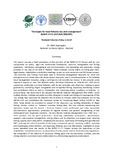| dc.description | This report provides a brief description of the structure of the REBYC-II CTI Project with its four components on policy, legal and institutional frameworks, resource management and fishing operations, information management and communication, and knowledge and awareness raising activities in two sites in the Gulf of Thailand. These consisted, among others, of fishing gear trials, legal reviews, stakeholder consultation meetings, as well as socio-economic and fish larvae surveys. The outcomes and findings have been used to formulate management measures for mesh size enlargement and closed area and closed season measures, and to provide guidance on formulating trawl management measures, using a participatory and consultative process. It also presents some important aspects on new Thai fisheries policy, the Royal Ordinance on Fisheries B.E. 2558 (2015) concerning small-scale and trawl fisheries, with its key principles and objectives, relating to good governance, combating illegal, unregulated and unreported fishing, improving monitoring, control and surveillance (MCS) as well as traceability, and improving labour conditions in fisheries. To achieve these, the Government has adopted the Marine Fisheries Management Plan (FMP), which outlines the key principle and policy priorities designed to tackle overfishing and overcapacity of the Thai fishing fleet, approved the National Plan of Action to Prevent, Deter and Eliminate IUU Fishing (NPOA-IUU), and established the Command Center for Combating Illegal Fishing (CCCIF) in May 2015. Some details are provided on several of the measures, e.g. tackling elimination of illegal fishing, Stricter control on Thailand’s overseas fishing fleet, the role Fisheries Monitoring and Operation Center and the Port-in – Port-out Centers, catch certification and other traceability documentation requirements, protection of migrant workers and general strengthening of law enforcement with respective sanctions. The new Marine Fisheries Management Plan (FMP) 2015 – 2019 provides also for good governance, increasing stakeholder participation, precautionary approach and adaptive management, among others, and its objectives and targets cover reducing fishing capacity and fishing effort, rebuilding fish resources, minimizing IUU fishing through effective MCS, reducing the catch of juveniles of the larger commercial species, resolving conflicts, restoring and maintaining critical habitats, and improving fisheries data and information. Highlights of some issues identified from the results of the REBYC II CTI Project include the importance of the stakeholder consultation process in preparation of policy advice used to formulate new regulations, the recognition of the diversity of resources, fishing gears and socioeconomic contexts, and the strong need for coordination and collaboration in a still evolving regulatory environment. | en |

